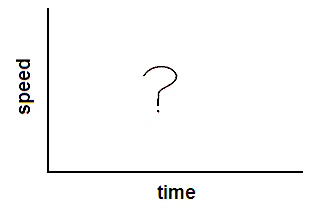
How do we describe the motion of a rolling ball on a horizontal surface? What does a graph of position vs. time for a rolling ball tell you? Does its speed change on the horizontal track?
Materials
Let's use this system to study how a ball rolls on a horizontal track and on a sloping ramp.

This design uses three sections of track; one for the ramp (lying on the long board) and two for the horizontal track. The track pieces are taped to the table and carefully joined so that the ball rolls smoothly down the ramp and along the horizontal track, without wobbling or jumping when it comes to a new section of track.
Prop a block or books so that the upper end is about 5 cm (2 ") high. Use the ramp to start the ball rolling. Release the ball from the same place every time (without pushing), so that it will do the same thing every time.
In order to study its motion, you will make measurements of how far the ball goes and how long it takes along various parts on the horizontal. From this we'll make conclusions about how its motion changes all along the horizontal track.
1. On the first data sheet record in Table 1 measurements of how long it takes for the ball to go from the beginning to end of the horizontal track, and the distance it travels in that time interval. Always release the ball at the same point at the top of the ramp.
Start timing the ball where the ramp ends and the horizontal track starts.
Stop timing at the end of the track.
Repeat this for 5 trials, and then calculate the median time (or the average, if you prefer. The median is easier to calculate).
2. Start the ball at the same place and in exactly the same way as you did in Question 1. Measure the time it takes for the ball to go a different distance along the horizontal track (not on the ramp). It could be half of the track, three quarters, or another distance you choose that is at least 50 cm long. Mark your "start timing" point and "end timing" point on the picture on the first page, and measure the distance.
Record your data in Table 2 on the first data sheet.
3. Start the ball exactly as you did in Question 1. Choose a different distance (still at least 50 cm and not on the ramp) for more trials, and put the results in Table 3.
4. Choose still a different distance and fill in Table 4.
5. Make a graph of distance vs. median time, using the four measurements you made. There is a graph layout on the second data sheet.
6. Interpret your graph. What does it tell you about the relationship between the distance the ball travels and the time it takes, on a horizontal track?
Speed is the measure of how fast something goes. You can calculate it by dividing the distance (that something goes) by the time (that it takes to go that far)
Speed = distance / time
7. Transfer your data from Tables 1, 2, 3, and 4 to complete the first two columns of table 5 (on the second data sheet). Use Columns 1 and 2 to calculate the speed of the ball for the 4 different spans of horizontal track that you measured. What can you conclude from your data table about the speed of a ball traveling along a horizontal track?
 8. Using your conclusions in question 7, what would a graph of speed vs. time look like? You don't need to assign scales to your graph. Just estimate what it would look like.
8. Using your conclusions in question 7, what would a graph of speed vs. time look like? You don't need to assign scales to your graph. Just estimate what it would look like.
Science Content: Uniform Motion